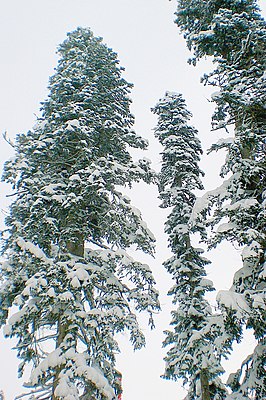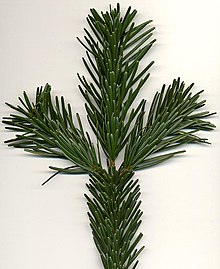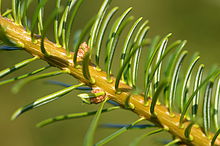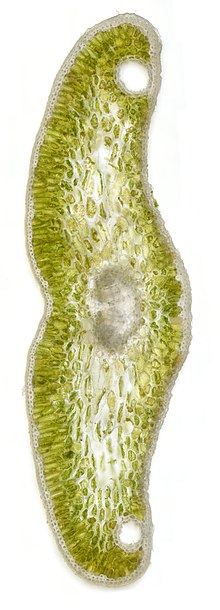Nordmann fir
| Nordmann fir | ||||||||||||
|---|---|---|---|---|---|---|---|---|---|---|---|---|

Snow-covered old Nordmann fir trees ( Abies nordmanniana ). |
||||||||||||
| Systematics | ||||||||||||
|
||||||||||||
| Scientific name | ||||||||||||
| Abies nordmanniana | ||||||||||||
| ( Stev. ) Spach |
The Nordmann fir ( Abies nordmanniana ), in the standard language Nordmann fir , also known as Nordmann fir and Caucasus fir , is a species of the species fir ( Abies ) in the pine family (Pinaceae). Today the Nordmann fir is the most widely used tree species as a Christmas tree .
General
It was named in 1842 after the Finnish biologist Alexander von Nordmann (1803-1866) after he discovered it in 1835 in the Caucasus northeast of Borjomi (in today's Georgia ).
description
Habitus
The Nordmann fir is a mighty, straight-stemmed, evergreen tree that reaches heights of 40 to 60 meters and a trunk diameter of up to 2 meters. It can reach a maximum age of 500 years. The densely beastete canopy is pyramidal, ranging in dense stands up to half tree height down. Older trees can, similar to the silver fir ( Abies alba ), form a so-called “stork's nest crown”. Freestanding trees are branched to the ground.
Buds and needles
The Nordmann fir forms 3 to 4 millimeters long, dark to red-brown colored, elongated, egg-shaped buds. The buds are always resin-free. They usually stand alone, but also in twos or threes at the shoot tips. The Nordmann fir has rigid, non-piercing needles 10 to 30 millimeters long and 2 to 3 millimeters wide. They are glossy dark green on the top and light green on the underside with two distinctive white stomatal stripes . The needle position depends on the position of the branch in the crown. Lower, shaded branches appear to have two-line needles. Branches in higher, more light-exposed positions have needles arranged in a spiral. These completely cover the shoot surface and are arranged like roof tiles. The needles stay on the tree for six to seven years before they fall off.
In the episode of the television program “ Ask noch die Maus ” broadcast on November 25, 2006 , 187,333 needles were counted on a Nordmann fir 1.63 m high, the average size of a German Christmas tree.
bark
The bark of the branches is thin and gray to brown in color. The bark of the upper trunk is smooth and has a grayish color, while the cracked bark of the base of the trunk is dark gray and clearly thicker.
root
Seedlings form a deep taproot , which is supplemented by strong side roots with age. The taproot stays alive even on shallow soils. Because of this, the Nordmann fir is extremely storm-proof. No information is available on mycorrhizal partners.
Wood
The soft and very rigid wood of the Nordmann fir has a whitish to yellowish color. There is no color difference between heartwood and sapwood. The annual rings are easy to see. The wood usually has no resin channels. After injuries, short-lived , traumatic resin canals that produce only a little resin develop .
| Mechanical properties | value | unit |
|---|---|---|
| Bulk density ( ) | 0.41 | g / cm³ |
| Compressive strength | 360 | kg / cm² |
Flowers, cones and seeds
The flowering time is in May. The 10 to 20 millimeters long, egg-shaped male cones have a reddish-brown to reddish-yellow color. They stand in the armpits of last year's needles and are mainly found in the lower crown area.
The upright female cones show first a greenish, later a yellow-green to reddish color. The cylindrical, red-brown cones covered with resin droplets have a length of 8 to 16 centimeters and a diameter of 3 to 5 centimeters. The seeds ripen from September to October. The winged seeds are about 1 centimeter in size. The almost square cover scales peek out from under the seed scales. There are two seeds per seed scale. The seed scales at the base of the cones usually remain sterile .
The wedge-shaped brown seeds are between 6 and 10 millimeters long and 5 to 8 millimeters wide. They have two purple or brown colored wings. The wings are twice to three times the size of the seeds. The germination capacity is 45 to 50%. The thousand grain mass is around 54 grams.
It is becoming more and more difficult for the climbing cone pickers to find old trees, as the firs are felled far too heavily on the Russian and Georgian mountain slopes in the Caucasus. In Germany, seed firs are already being grown in the Eifel .
Occurrence
The Nordmann fir is native to the western Caucasus and the Eastern Pontic Mountains in Georgia , Russia , north-eastern Turkey and Azerbaijan . Their area of distribution does not form a contiguous area. The total area of the distribution area in the Eastern Pontic Mountains covers around 13,200 hectares.
It grows in a cool, humid climate on deep, humus clay soils at altitudes between 900 (individual trees even from 400) and 2,100 meters. She prefers north-facing slopes. It is lime-tolerant and forms pure stands or mixed forests with the Caucasus spruce ( Picea orientalis ) and the oriental beech ( Fagus orientalis ).
Due to its deep root system, the Nordmann fir is often planted in mixed forests to make them more storm-proof.

Systematics
The first description of this species was in 1838 under the name Pinus nordmanniana by Christian von Steven in Bulletin de la Société Imperiale des Naturalistes de Moscou , 1, p. 45, plate 2. Édouard Spach put in 1841 in Histoire Naturelle des Végétaux. Phanerogames , 11, p. 418 this species under the current species name Abies nordmanniana in the genus Abies . Abies nordmanniana belongs to the Abies section in the Abies genus .
Of Abies NORDMANNIANA (Steven) Spach There are two subspecies:
- Abies nordmanniana (Steven) Spach subsp. nordmanniana (Syn .: Pinus nordmanniana Steven , Picea nordmanniana (Steven) Loudon , Pinus abies var. nordmanniana (Steven) Mueller , Abies leioclada Steven ex Gordon & Glend. , Abies pectinata var. leioclada (Steven ex Endl.) Link ex Carrière ) : It originally occurs from northeastern Turkey to western Transcaucasia.
- Troy fir ( Abies nordmanniana subsp. Equi-trojani (Aschers. & Sint. Ex Boiss.) Coode & Cullen , Syn .: Abies equi-trojani (Asch. & Sint. Ex Boiss.) Mattf. , Abies nordmanniana var. Equi -trojani Guinier & Maire , Abies pectinata var. equi-trojani Aschers. & Sint. ex Boiss. , Abies bornmuelleriana Mattfeld , Abies cephalonica var. graeca (Fraas) Tang S.Liu ): It is native to northwestern Turkey.
Pests
In its natural range, the Nordmann fir is hardly threatened by diseases and insect pests. The small pine bark beetle ( Cryphalus piceae ), the silver pine shoot ( Dreyfusia nordmannianae ) and some needle-eating beetle species that hardly cause any major damage are named as pests . None of the parasitic fungus species specialize in the Nordmann fir.
use
Due to its small distribution area, the Nordmann fir has hardly any economic importance in its home country. Their wood is used to make pulp and paper.
In Central Europe , the Nordmann fir is rarely cultivated in forestry, as it suffers from severe winters and late frost. However, it is a popular park tree and is grown on a plantation basis as a Christmas tree.
The most important Christmas tree producer is Denmark with around 4,000 (large) producers and a stock of over 100 million Nordmann firs, of which around 5 million are exported annually. The largest European nursery for Nordmann Christmas trees is the Danish Green Team Group; HedeDanmark, a subsidiary of the Danish Heidegesellschaft, is one of the big names in the industry. A large Danish importer of Nordmann fir seeds is Levinsen & Abies. The seeds are mainly collected in the region east of the Schaori reservoir in the Ratscha-Letschchumi district around the Georgian villages Nikorzminda in the municipalities of Ambrolauri and Tlugi .
Yields per hectare of the Nordmann fir in the Christmas tree plantation culture amount to between 32,000 and 154,000 euros, depending on the quality of origin used.
swell
- Cemil Ata: Abies nordmanniana . In: Peter Schütt, Horst Weisgerber, Hans J. Schuck, Ulla Lang, Bernd Stimm, Andreas Roloff: Lexicon of Conifers. Distribution - Description - Ecology - Use; the great encyclopedia . Nikol, Hamburg 2004, ISBN 3-933203-80-5 , p. 59-68 .
- Christopher J. Earle: Abies nordmanniana. In: The Gymnosperm Database. Retrieved on December 18, 2010 (English, section description and systematics).
Individual evidence
- ↑ a b Abies nordmanniana. In: Germplasm Resources Information Network - (GRIN). USDA, accessed November 12, 2011 .
- ↑ Abies NORDMANNIANA in the endangered Red List species the IUCN 2006. Posted by: Conifer Specialist Group, 1998. Retrieved on 12 May, 2006.
- ↑ a b Rafaël Govaerts (Ed.): Abies nordmanniana. In: World Checklist of Selected Plant Families (WCSP) - The Board of Trustees of the Royal Botanic Gardens, Kew . Retrieved April 3, 2019.
- ↑ Fir production: Denmark's business with Christmas trees , welt.de , December 20, 2010
- ↑ [1]
- ↑ Economy Where do our Christmas trees come from? , Märkische Allgemeine Zeitung, December 19, 2017
- ↑ Jürgen Matschke (2010): Nordmannstanne - seed plantations for secure supply . LWF aktuell 79, pp. 42 - 44. Online version: February 9, 2011 PDF
Web links
- Drawing of the descriptive characteristics of the Nordmann fir from the publication Pinaceae of the International Association for Plant Taxonomy by Aljos Farjon [2]
- Abies NORDMANNIANA in the endangered Red List species the IUCN 2006. Posted by: Conifer Specialist Group, 1998. Retrieved on 12 May, 2006.
- Thomas Meyer: Data sheet with identification key and photos at Flora-de: Flora von Deutschland (old name of the website: Flowers in Swabia )







